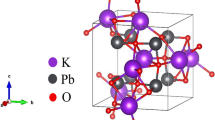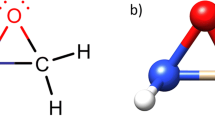Abstract
Nonrelativistic and relativistic (Douglas-Kroll-Hess, DKH) segmented all-electron Gaussian basis sets of valence triple zeta quality plus polarization functions (TZP) for the lanthanides were developed. As some atomic and molecular properties depend on a good description of the electrons far from the nuclei, these basis sets are augmented with diffuse functions, giving rise to the augmented TZP (ATZP) and ATZP-DKH basis sets. At the DKH level of theory, the B3LYP hybrid functional in conjunction with the TZP-DKH basis set were used to calculate the atomic charges and valence orbital populations of the lanthanide and oxygen atoms, the bond lengths, and the equilibrium dissociation energies of lanthanide monoxides. The DKH-B3LYP/ATZP-DKH polarizability of Yb and the DKH-M06/TZP-DKH first ionization energies of the lanthanides are also reported. Compared with the values obtained with a larger all-electron basis set, and theoretical and experimental data found in the literature, data obtained by our compact basis sets are verified to be accurate and reliable. Unlike effective core potential valence basis sets, our basis sets can also be employed in molecular property calculations that involve the simultaneous treatment of core and valence electrons.

ᅟ
Similar content being viewed by others
References
Sakamoto M, Manseki K, Okawa H (2001) d–f Heteronuclear complexes: synthesis, structures and physicochemical aspects. Coord Chem Rev 219–221:379–414
Bunzli JC, Piguet C (2002) Lanthanide-containing molecular and supramolecular polymetallic functional assemblies. Chem Rev 102:1897–1928
Kido J, Okamoto Y (2002) Organo lanthanide metal complexes for electroluminescent materials. Chem Rev 102:2357–2368
Fricker SP (2006) The therapeutic application of lanthanides. Chem Soc Rev 35:524–533
Marjolin A, Gourlaouen C, Clavaguéra C et al (2014) Hydration gibbs free energies of open and closed shell trivalent lanthanide and actinide cations from polarizable molecular dynamics. J Mol Model 20:2471
Freire RO, Rocha GB, Simas AM (2006) Lanthanide complex coordination polyhedron geometry prediction accuracies of ab initio effective core potential calculations. J Mol Model 12:373–389
Yang Y, Fang Y, Liu J et al (2015) Complexation behavior of Eu(III), Tb(III), tm(III), and am(III) with three 1,10-phenanthroline-type ligands: insights from density functional theory. J Mol Model 21:185
Salahub DR, Zerner MC (eds) 1989 The Challenge of d and f Electrons. Theory and computation, ACS symposium series, vol 394. American Chemical Society, Washington
Cundari TR, Stevens WJ (1993) Effective core potential methods for the lanthanides. J Chem Phys 98:5555–5565
Ross RB, Gayen S, Ermler WC (1994) Ab initio relativistic effective potentials with spin–orbit operators. V. Ce through Lu. J Chem Phys 100:8145–8155
Cao X, Dolg M (2002) Segmented contraction scheme for small-core lanthanide pseudopotential basis sets. J Mol Struct (THEOCHEM) 581:139–147
Hülsen M, Weigand A, Dolg M (2009) Quasirelativistic energy-consistent 4f-in-core pseudopotentials for tetravalent lanthanide elements. Theor Chem Accounts 122:23–29
Vyboishchikov SF, Sierraalta A, Frenking G (1997) Topological analysis of electron density distribution taken from a pseudopotential calculation. J Comput Chem 18:416–429
Güell V, Luis JM, Solà M, Swart M (2008) Importance of the basis set for the spin-state energetics of Iron complexes. J Phys Chem A 112:6384–6391
Cirera J, Ruiz E (2008) Exchange coupling in CuIIGdIII dinuclear complexes: a theoretical perspective. C R Chim 11:1227–1234
Douglas M, Kroll NM (1974) Quantum electrodynamical corrections to the fine structure of helium. Ann Phys (NY) 82:89–155
Hess BA (1985) Applicability of the no-pair equation with free-particle projection operators to atomic and molecular structure calculations. Phys Rev A 32:756–763
Hess BA (1986) Relativistic electronic-structure calculations employing a two-component no-pair formalism with external-field projection operators. Phys Rev A 33:3742–3748
Kellö V, Sadlej AJ (1998) Picture change and calculations of expectation values in approximate relativistic theories. Int J Quantum Chem 68:159–174
Baerends EJ, Schwarz WHE, Schwerdtfeger P, Snijders JG (1990) Relativistic atomic orbital contractions and expansions: magnitudes and explanations. J Phys B: At Mol Phys 23:3225–3240
Autschbach J, Peng D, Reiher M (2012) Two-component relativistic calculations of electric-field gradients using exact decoupling methods: spin−orbit and picture-change effects. J Chem Theory Comput 8:4239–4248
Te Velde G, Bickelhaupt FM, Baerends EJ, Guerra CF, Van Gisbergen SJA, Snijders JG, Ziegler T (2001) Chemistry with ADF. J Comput Chem 22:931–967
Roos BO, Lindh R, Malmqvist P-Å, Veryazov V, Widmark P-O, Borin AC (2008) New relativistic atomic natural orbital basis sets for lanthanide atoms with applications to the Ce diatom and LuF3. J Phys Chem A 112:11431–11435
Tsuchiya T, Abe M, Nakajima T, Hirao K (2001) Accurate relativistic Gaussian basis sets for H through Lr determined by atomic self-consistent field calculations with the third-order Douglas–Kroll approximation. J Chem Phys 115:4463–4472
Nakajima T, Hirao K (2002) Accurate relativistic Gaussian basis sets determined by the third-order Douglas–Kroll approximation with a finite-nucleus model. J Chem Phys 116:8270–8275
Sekiya M, Noro T, Miyoshi E, Osanai Y, Koga T (2006) Relativistic correlating basis sets for lanthanide atoms from Ce to Lu. J Comput Chem 27:463–470
Lu Q, Peterson KA (2016) Correlation consistent basis sets for lanthanides: the atoms La-Lu. J Chem Phys 145:054111
Gomes ASP, Dyall KG, Visscher L (2010) Relativistic double-zeta, triple-zeta, and quadruple-zeta basis sets for the lanthanides La–Lu. Theor Chem Accounts 127:369–381
Pantazis DA, Neese F (2009) All-Electron scalar relativistic basis sets for the lanthanides. J Chem Theory Comput 5:2229–2238
Dolg M (2011) Segmented contracted Douglas–Kroll–Hess adapted basis sets for lanthanides. J Chem Theory Comput 7:3131–3142
Barbieri PL, Fantin PA, Jorge FE (2006) Gaussian basis sets of triple and quadruple zeta valence quality for correlated wave functions. Mol Phys 104:2945–2954
Machado SF, Camiletti GG, Canal Neto A, Jorge FE, Jorge RS (2009) Gaussian basis set of triple zeta valence quality for the atoms from K to Kr: application in DFT and CCSD(T) calculations of molecular properties. Mol Phys 107:1713–1727
Campos CT, Jorge FE (2013) Triple zeta quality basis sets for atoms Rb through Xe: application in CCSD(T) atomic and molecular property calculations. Mol Phys 111:167–173
Jorge FE, Canal Neto A, Camiletti GG, Machado SF (2009) Contracted Gaussian basis sets for Douglas-Kroll-Hess calculations: estimating scalar relativistic effects of some atomic and molecular properties. J Chem Phys 130:064108
Martins LSC, Jorge FE, Machado SF (2015) All-electron segmented contraction basis sets of triple zeta valence quality for the fifth-row elements. Mol Phys 113:3578–3586
Campos CT, de Oliveira AZ, Ferreira IB, Jorge FE, Martins LSC (2017) Segmented all-electron Gaussian basis sets of double and triple zeta qualities for Fr, Ra, and Ac. Chem Phys Lett 675:1–5
Fantin PA, Barbieri PL, Canal Neto A, Jorge FE (2007) Augmented Gaussian basis sets of triple and quadruple zeta valence quality for the atoms H and from li to Ar: applications in HF, MP2, and DFT calculations of molecular dipole moment and dipole (hyper)polarizability. J Mol Struct (THEOCHEM) 810:103–111
Camiletti GG, Canal Neto A, Jorge FE, Machado SF (2009) Augmented Gaussian basis sets of double and triple zeta valence qualities for the atoms K and Sc-Kr: applications in HF, MP2, and DFT calculations of molecular electric properties. J Mol Struct (THEOCHEM) 910:122–125
Martins LSC, de Souza FAL, Ceolin GA, Jorge FE, de Berrêdo RC, Campos CT (2013) Augmented Gaussian basis sets for the elements K, Sc-Kr, Rb, and Y-Xe: application in HF, MP2, and DFT calculations of molecular electric properties. Compt Theor Chem 1013:62–69
Campos CT, Jorge FE, Alves JMA (2012) XZP+1d and XZP+1d-DKH basis sets for second-row elements: application to CCSD(T) zero-point vibrational energy and atomization energy calculations. J Mol Model 18:4081–4088
Antusek A, Sulka M (2016) Ab initio calculations of NMR shielding of Sc3+, Y3+ and La3+ ions in the water solution and 45Sc, 89Y, 138La and 139La nuclear magnetic dipole moments. Chem Phys Lett 660:127–131
Jorge FE, Venâncio JRC (2018) Structure, stability, catalytic activity, and polarizabilities of small iridium clusters. Chin Phys B 27:063102
Novikov AS, Ivanov DM, Avdontceva MS, Kukushkin VY (2017) Diiodomethane as a halogen bond donor toward metal-bound halides. Cryst Eng Comm 19:2517–2525
Galembeck SE, Caramori GF, Misturini A, Garcia LC, Orenha RP (2017) Metal–ligand bonding situation in ruthenophanes containing mMultibridged cyclophanes. Organometallics 36:3465–3470
Zhang Y, Miao H, Liu L, Zhang X, King RB (2017) Binuclear chromium carbonyl complexes of the highly basic small bite bidentate diphosphine bis(dimethylphosphino)methane. Polyhedron 138:194–205
Chakravorty SJ, Corongiu G, Flores JR, Sonnad V, Clementi E, Carravetta V, Cacelli I (1989) Modern techniques in computational chemistry MOTECC-89. ESCOM, Leiden
De Castro EVR, Jorge FE, Pinheiro JC (1999) Accurate Gaussian basis sets for second-row atoms and ions generated with the improved generator coordinate Hartree–Fock method. Chem Phys 243:1–7
Frisch MJ et al (2009) GAUSSIAN 09, revision A.02. GAUSSIAN Inc., Wallingford CT
De Jong WA, Harrison RJ, Dixon DA (2001) Parallel Douglas–Kroll energy and gradients in NWChem: estimating scalar relativistic effects using Douglas–Kroll contracted basis sets. J Chem Phys 114:48–53
Brummelhuis R, Siedentop H Stockmeyer E 2002The ground-state energy of relativistic one-electron atoms according to Jansen and Hess. Doc Math 7:167–182
Becke AD (1993) Density functional thermochemistry. III. The role of exact exchange. J Chem Phys 98:5648–5652
Lee C, Yang W, Parr RG (1988) Development of the Colle-Salvetti correlation-energy formula into a functional of the electron density. Phys Rev B 37:785–789
Reed AE, Curtiss LA, Weinhold F (1988) Intermolecular interactions from a natural bond orbital, donor-acceptor viewpoint. Chem Rev 88:899–926
Zhao Y, Truhlar DG (2006) The M06 suite of density Functionals for Main group thermochemistry, thermochemical kinetics, noncovalent interactions, excited states, and transition elements: two new Functionals and systematic testing of four M06 Functionals and twelve other Functionals. Theor Chem Accounts 120:215–241
Linstrom PJ, Mallard WG (eds) (2005) NIST Chemistry WebBook, NIST Standard Reference Database Number 69. National Institute of Standards and Technology, Gaithersburg
Wu ZJ, Guan W, Meng J, Su ZM (2007) Density functional studies of diatomic LaO to LuO. J Clust Sci 18:444–458
Wang SG, Schwarz WHE (1995) Lanthanide Diatomics and lanthanide contractions. J Phys Chem 99:11687–11695
Xu W, Ji W-X, Wang S-G (2015) The electronic configurations of LnX (Ln = La–Eu, X = O, S, Se, Te): A FON–DFT investigation. Compt Theor Chem 1068:81–87
Ramakrishnan R, Matveev AV, Rosch N (2009) The DFT + U method in the linear combination of Gaussian-type orbitals framework: role of 4f orbitals in the bonding of LuF3. Chem Phys Lett 468:158–161
Huber KP, Herzberg G (1979) Molecular spectra and molecular structure, constants of diatomic molecules, vol IV. Van Nostrand Reinhold, New York
Shenyavskaya EA, Bernard A, Vergès J (2003) High resolution study of near-infrared emission spectra of 142NdO. J Mol Spectrosc 222:240–247
Chandrasekharaiah MS, Gingerich KA (1989) In: Gschniedner Jr KA, Erying L (eds) Handbook on the Chemistry and Physics of Rare Earths, vol 12, Chapter 86. Elsevier, Amsterdam
Haire RG (1994) High-temperature vaporization of transplutonium oxides. J Alloys Compd 213/214:185–190
Dulick M, Murad E, Barrow RF (1986) Thermochemical properties of the rare earth monoxides. J Chem Phys 85:385–390
Konings RJM, Beneš O, Kovács A, Manara D, Sedmidubský D, Gorokhov L, Iorish VS, Yungman V, Shenyavskaya E, Osina E (2014) The Thermodynamic Properties of the f-Elements and their Compounds. Part 2. The Lanthanide and Actinide Oxides. J Phys Chem Ref Data 43:013101
Kovács A, Konings RJM, Szieberth D, Krámos B (2014) Study of the an-cl bond contraction in actinide trichlorides. Struct Chem 25:991–996
Kovács A, Konings RJM (2004) Structure and vibrations of lanthanide Trihalides: an assessment of experimental and theoretical data. J Phys Chem Ref Data 33:377–404
Thierfelder C, Schwerdtfeger P (2009) Relativistic couple-cluster calculations. Phys Rev A 79:032512
De Oliveira AZ, Campos CT, Jorge FE, Ferreira IB, Fantin PA (2018) All-electron triple zeta basis sets for the actinides. Compt Theor Chem 1135:28–33
Acknowledgments
We would like to acknowledge the financial support of Conselho Nacional de Desenvolvimento Científico e Tecnológico, Coordenação de Aperfeiçoamento de Pessoal de Nível Superior, and Fundação de Amparo à Pesquisa e Inovação do Espírito Santo (Brazilian Agencies).
Author information
Authors and Affiliations
Corresponding author
Additional information
Publisher’s note
Springer Nature remains neutral with regard to jurisdictional claims in published maps and institutional affiliations.
Rights and permissions
About this article
Cite this article
de Oliveira, A.Z., Ferreira, I.B., Campos, C.T. et al. Segmented all-electron basis sets of triple zeta quality for the lanthanides: application to structure calculations of lanthanide monoxides. J Mol Model 25, 38 (2019). https://doi.org/10.1007/s00894-019-3924-8
Received:
Accepted:
Published:
DOI: https://doi.org/10.1007/s00894-019-3924-8




